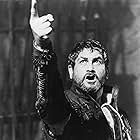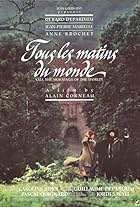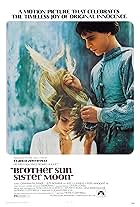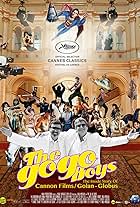Verdi's famous opera is brought to life in this production. The immortal tale of the noble Moor and his beautiful young wife, and of his lieutenant, whose jealousy and lust for power lead hi... Read allVerdi's famous opera is brought to life in this production. The immortal tale of the noble Moor and his beautiful young wife, and of his lieutenant, whose jealousy and lust for power lead him to commit the ultimate treason.Verdi's famous opera is brought to life in this production. The immortal tale of the noble Moor and his beautiful young wife, and of his lieutenant, whose jealousy and lust for power lead him to commit the ultimate treason.
- Nominated for 1 Oscar
- 2 wins & 8 nominations total
David Allen Mann
- Venetian Officer
- (uncredited)
Daniela Merlo
- Member of Chorus
- (uncredited)
Storyline
Did you know
- TriviaFranco Zeffirelli later said that out of all the films he ever made, "Otello" is his favorite, and admitted that after he made the picture, he had "a bit of a crisis" because he felt that he could never be able to duplicate that achievement.
- ConnectionsFeatured in The Go-Go Boys: The Inside Story of Cannon Films (2014)
Featured review
The very beginning of OTELLO with everything so vastly bigger than reality sets the tone for our expectations. Some are disappointed, others are surprised.
It seems, having found out Franco Zeffirelli's entire filmography, that the key movie which truly delivers the director's masterful eye for details as well as the desirable faithfulness in adapting the classical source to the screen is TRAVIATA with Placido Domingo and Teresa Stratas. There, you do not have to be particularly fond of opera to love it. Indeed, echoing Vincent Canby's words of September 1986, in TRAVIATA "opera and film are effortlessly made to seem one." OTELLO, made 5 years later with the great tenor in the lead, appears to be a slightly different case in which aesthetic beauty is combined with classic tragedy but the manner is ultimately individual.
The 2013 Year of Verdi may constitute a wonderful opportunity to broaden one's knowledge of this great composer, the genius of his time. However, many viewers who have seen Franco Zeffirelli's OTELLO will probably agree with the New York Times reviewer, Vincent Canby, that, unlike TRAVIATA, the movie rather "ornaments" the original than "reveals" it. Therefore, from the very opening shot with its grandeur and the majestic display of elaborate visuals rather than Verdi's storm music (which appears to be in the shadow of spectacle), OTELLO is foremost an expression of the director's style.
Yes, it is more Zeffirelli than Verdi in its divided pieces, some chaotic continuity, dreamlike photography by the director's mainstay, Ennio Guarnieri, aestheticism and the vital, engrossing and a little terrifying conclusion. At certain moments, visuals and symbols appear to be supplied with an almost spiritual piety. Such care is being handled, such effort being put to everything. Although it may consist of certain liberties with the original source, nothing seems to stand in the way towards leaving the viewer dazzled at the creative use of images, dazzling costumes, breathtaking colors, camera angles and the cast who make it all beautifully acted and sung. They allow you to search into their souls. Yes, they will completely captivate you.
Of course, the nature of this movie, opera, makes the performances considerably overacted. Viewers who are not used to such pompous execution of the sung lines may feel at odds with the over-dramatized moments. Yet, Zeffirelli, as in many (of not all) of his other movies supplies us with beautiful characters whose looks alone somehow make them easily identified with and likable. The pairing of Placido Domingo as Otello and Katia Ricciarelli as Desdemona rewards us all. By splendid combination of emotional resonance and the dramatic tensions, they deliver exceptionally memorable moments, in particular their wedding night which is a true visual poetry on screen. Domingo beautifully highlights the typical way of a tragic hero - from victory to tragedy, from pride to humiliation, from being hailed to being doomed. Ricciarelli is a delicate dove, an innocent victim, a truly beautiful creature born under evil star. She is incredible in the scene of the prayer at the shroud of Madonna. Piety, subtlety and dignity reach exquisite harmony and surprising balance. Yet, however they differ, as it is in the classical tragedy, they both fall victims of evil scheme, of the hero's evil genius.
One line says: "Beware of jealousy!" This, unfortunately, did not apply to "Beware of an evil man!" Justino Diaz portrays Jago, a malicious man who believes in a god of vengeance...that is his creed. His demonic laughter allures all major human emotions. It is him who plants the seeds of doubt about Desdemona and her alleged lover, Cassio (Urbano Barberini) and his poison really works in the hero's mind. In one of the most powerful scenes of the movie, Jago stands at the cross in a typical Zeffirelli imagery (compare to the film about saint Francis) and, on the verge of blasphemy, he sings out in pride and vanity "Heaven is an idle tale" That scene has its continuation at Otello's oath. Zeffirelli delivers a splendid performance from Justino Diaz, the most memorable character/villain of the movie.
From the supporting cast, a mention must be made of Urbano Barberini. Here, the classical idea of beauty, sort of Michelangelo's David is evoked, in particular, at the additional scene (which Canby relates to as 'gross interruption') when Cassio is showed succumbed to the wild pleasures of erotic dreams about Desdemona. Barberini evokes a certain aspect of an innocent young man so many times depicted by Zeffirelli with its pinnacle in ROMEO AND JULIET.
With the marvelous display of visuals, aesthetic splendor and the director's standard hallmarks, Zeffirelli has never and will never win the hearts of those who are bound to criticize him. Yet, OTELLO may be forgiven its liberal treatments of the classical source and may be considered a significant film by those seeking high art on screen.
It seems, having found out Franco Zeffirelli's entire filmography, that the key movie which truly delivers the director's masterful eye for details as well as the desirable faithfulness in adapting the classical source to the screen is TRAVIATA with Placido Domingo and Teresa Stratas. There, you do not have to be particularly fond of opera to love it. Indeed, echoing Vincent Canby's words of September 1986, in TRAVIATA "opera and film are effortlessly made to seem one." OTELLO, made 5 years later with the great tenor in the lead, appears to be a slightly different case in which aesthetic beauty is combined with classic tragedy but the manner is ultimately individual.
The 2013 Year of Verdi may constitute a wonderful opportunity to broaden one's knowledge of this great composer, the genius of his time. However, many viewers who have seen Franco Zeffirelli's OTELLO will probably agree with the New York Times reviewer, Vincent Canby, that, unlike TRAVIATA, the movie rather "ornaments" the original than "reveals" it. Therefore, from the very opening shot with its grandeur and the majestic display of elaborate visuals rather than Verdi's storm music (which appears to be in the shadow of spectacle), OTELLO is foremost an expression of the director's style.
Yes, it is more Zeffirelli than Verdi in its divided pieces, some chaotic continuity, dreamlike photography by the director's mainstay, Ennio Guarnieri, aestheticism and the vital, engrossing and a little terrifying conclusion. At certain moments, visuals and symbols appear to be supplied with an almost spiritual piety. Such care is being handled, such effort being put to everything. Although it may consist of certain liberties with the original source, nothing seems to stand in the way towards leaving the viewer dazzled at the creative use of images, dazzling costumes, breathtaking colors, camera angles and the cast who make it all beautifully acted and sung. They allow you to search into their souls. Yes, they will completely captivate you.
Of course, the nature of this movie, opera, makes the performances considerably overacted. Viewers who are not used to such pompous execution of the sung lines may feel at odds with the over-dramatized moments. Yet, Zeffirelli, as in many (of not all) of his other movies supplies us with beautiful characters whose looks alone somehow make them easily identified with and likable. The pairing of Placido Domingo as Otello and Katia Ricciarelli as Desdemona rewards us all. By splendid combination of emotional resonance and the dramatic tensions, they deliver exceptionally memorable moments, in particular their wedding night which is a true visual poetry on screen. Domingo beautifully highlights the typical way of a tragic hero - from victory to tragedy, from pride to humiliation, from being hailed to being doomed. Ricciarelli is a delicate dove, an innocent victim, a truly beautiful creature born under evil star. She is incredible in the scene of the prayer at the shroud of Madonna. Piety, subtlety and dignity reach exquisite harmony and surprising balance. Yet, however they differ, as it is in the classical tragedy, they both fall victims of evil scheme, of the hero's evil genius.
One line says: "Beware of jealousy!" This, unfortunately, did not apply to "Beware of an evil man!" Justino Diaz portrays Jago, a malicious man who believes in a god of vengeance...that is his creed. His demonic laughter allures all major human emotions. It is him who plants the seeds of doubt about Desdemona and her alleged lover, Cassio (Urbano Barberini) and his poison really works in the hero's mind. In one of the most powerful scenes of the movie, Jago stands at the cross in a typical Zeffirelli imagery (compare to the film about saint Francis) and, on the verge of blasphemy, he sings out in pride and vanity "Heaven is an idle tale" That scene has its continuation at Otello's oath. Zeffirelli delivers a splendid performance from Justino Diaz, the most memorable character/villain of the movie.
From the supporting cast, a mention must be made of Urbano Barberini. Here, the classical idea of beauty, sort of Michelangelo's David is evoked, in particular, at the additional scene (which Canby relates to as 'gross interruption') when Cassio is showed succumbed to the wild pleasures of erotic dreams about Desdemona. Barberini evokes a certain aspect of an innocent young man so many times depicted by Zeffirelli with its pinnacle in ROMEO AND JULIET.
With the marvelous display of visuals, aesthetic splendor and the director's standard hallmarks, Zeffirelli has never and will never win the hearts of those who are bound to criticize him. Yet, OTELLO may be forgiven its liberal treatments of the classical source and may be considered a significant film by those seeking high art on screen.
- marcin_kukuczka
- Feb 11, 2013
- Permalink
- How long is Otello?Powered by Alexa
Details
- Release date
- Countries of origin
- Language
- Also known as
- Otelo
- Filming locations
- Heraklion, Crete, Greece(exterior scenes)
- Production companies
- See more company credits at IMDbPro
Box office
- Gross US & Canada
- $189,042
- Opening weekend US & Canada
- $23,076
- Sep 14, 1986
- Runtime1 hour 58 minutes
- Sound mix
- Aspect ratio
- 1.66 : 1
Contribute to this page
Suggest an edit or add missing content


























